The Commercial Wine Dispenser Market is estimated to be valued at USD 1.9 billion in 2025 and is projected to reach USD 3.1 billion by 2035, registering a compound annual growth rate (CAGR) of 5.1% over the forecast period.

The commercial wine dispenser market is experiencing notable growth, driven by rising demand for wine preservation, premium service experiences, and operational efficiency in the hospitality sector. Businesses are increasingly adopting automated dispensing systems to reduce wastage, ensure consistent serving quality, and enhance customer engagement.
Shifts in consumer preferences toward by-the-glass offerings and premiumization of wine lists have further fueled adoption across restaurants, cafes, and bars. Future growth is expected to be supported by innovations in temperature control, hygienic materials, and energy-efficient designs that align with sustainability objectives.
ncreasing focus on staff productivity, customer satisfaction, and aesthetic integration into dining environments is also paving the way for higher adoption, with opportunities emerging from customization and integration with digital payment and loyalty platforms.
The market is segmented by Type and End-use and region. By Type, the market is divided into Automatic, Semi-automatic, and Manual. In terms of End-use, the market is classified into Restaurants & Cafes, Brewpubs, Bars, Hotels & Resorts, and Households. Regionally, the market is classified into North America, Latin America, Western Europe, Eastern Europe, Balkan & Baltic Countries, Russia & Belarus, Central Asia, East Asia, South Asia & Pacific, and the Middle East & Africa.
The market is segmented by Type and End-use and region. By Type, the market is divided into Automatic, Semi-automatic, and Manual. In terms of End-use, the market is classified into Restaurants & Cafes, Brewpubs, Bars, Hotels & Resorts, and Households. Regionally, the market is classified into North America, Latin America, Western Europe, Eastern Europe, Balkan & Baltic Countries, Russia & Belarus, Central Asia, East Asia, South Asia & Pacific, and the Middle East & Africa.
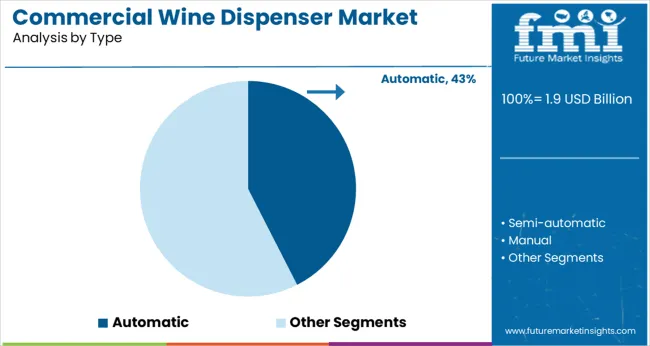
When segmented by type, the automatic segment is projected to hold 42.5% of the total market revenue in 2025, establishing itself as the leading type. This dominance has been driven by the need for precision in portion control, minimized human error, and enhanced customer experience through seamless operation.
Automatic dispensers have been increasingly adopted as they enable staff to serve accurately measured pours while maintaining the integrity and freshness of wine for extended periods. The ability to integrate touchless features, programmable settings, and advanced cooling mechanisms has reinforced their suitability for busy commercial environments.
Additionally, their contribution to reducing operational costs and optimizing inventory management has positioned automatic dispensers as the preferred choice for businesses seeking efficiency and consistency in service delivery.

Segmented by end use, restaurants and cafes are expected to account for 37.0% of the commercial wine dispenser market revenue in 2025, maintaining their leadership position. This prominence has been supported by the role of wine in enhancing dining experiences and the necessity to offer high-quality by-the-glass options without compromising freshness
Restaurants and cafes have been increasingly investing in wine dispensers to attract discerning customers and to differentiate their offerings in competitive urban markets.
These establishments benefit from improved service speed, reduced wastage, and the ability to showcase a wider variety of wines, which aligns with evolving consumer expectations. Furthermore, the aesthetic appeal and space efficiency of modern dispensers have facilitated their integration into diverse dining formats, cementing the segment’s position as the key driver of growth in the market.
As per the analysis of Future Market Insights, people across the globe are spending more on food and recreational activities, owing to their rise in earnings across developing economies. The surge in consumer income has led to an increase in annual away-from-home expenditures such as convenience food, fast food, alcoholic beverages, non-alcoholic beverages, and more.
These aspects are also raising the consumption of wine with dining-out facilities, thereby propelling the growth of the commercial wine dispenser market.
After analyzing the market in-depth, the experts of FMI have unveiled that the commercial wine dispenser market has been witnessing an unprecedented surge in the past few years. There is an approximate rise of USD 1.9 million surge in the total market value from 2025 to 2025. The market during the period 2020 to 2025 registered a CAGR of 4.5%.
The growth of the market can be attributed to the fact that commercial wine dispensers are getting equipped with advanced technologies that are making the job easier for bars, fine-dining restaurants, and other commercial food outlets to serve wine to their customers.
The commercial wine dispensers are fitted with self-cleaning technologies, that allow the machine the clean itself automatically after a specified amount of drink or a number of glasses has been dispensed. There is a diverse range of products that include home wine dispenser, boxed wine dispenser, smart wine dispenser, and more.
It has been analyzed by experts that FMI that with the advancement of technology and the desire to reduce dependency, several automatic devices have been installed that allows users to instruct the machine to dispense the drink on their own.
The commercial wine dispensers are long-lasting and may be utilized during occasions. Additionally, health awareness amongst the population owing to the consumption of red wine is a key factor bolstering the adoption of commercial wine dispensers through 2025.
Semi-Automatic Wine Dispenser - By Type
It has been analyzed by the experts at FMI that the semi-automatic commercial wine dispensers are likely to gain the most prominent during the forecast period. As per the data collected in the study, the semi-automatic segment accounted for the largest market share during the base year. It registered a CAGR of 8.57% in the year 2025. The factors attributing to the rising market shares for semi-automatic dispensers are as follows:
Restaurants & Bars - By End-use
The increasing trend of dining out amongst the urban and millennial populace is expanding the market share of restaurant chains across the globe. The commercial sector is in tandem with the changing preferences of consumers.
The restaurants and bars accounted for the maximum shares and are witnessed to progress at a considerable pace, registering a CAGR of 8.71% through the forecast period. The factors responsible for the propulsion of this segment are:
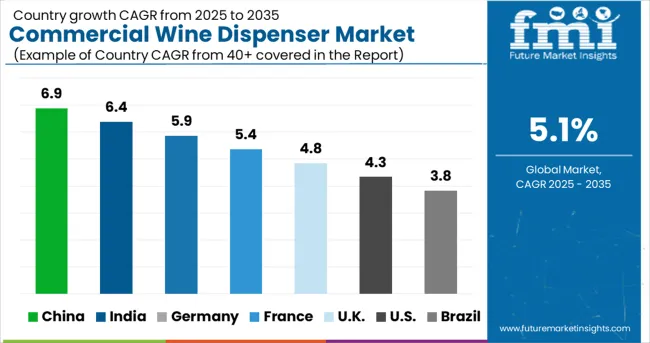
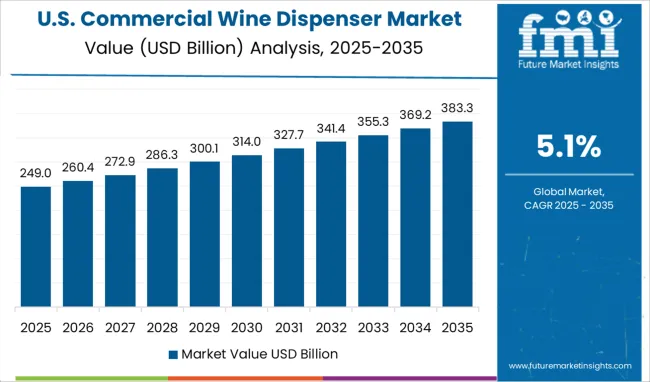
| Country/Region | United States |
|---|---|
| Statistics | North America is projected to dominate the commercial wine dispenser market through the forecast period, advancing at a CAGR of 8.62% through 2035. the United States has emerged as the dominating country, followed by Canada in the concerned region. |
| Growth Propellants | The factors responsible for the growth of the USA commercial wine dispenser market are:
|

| Country/Region | Europe |
|---|---|
| Statistics | The European commercial wine dispenser market is anticipated to register staggering growth over the forecast period. The wine market in Europe is projected to advance at a moderate-paced CAGR of 7.6% through the estimated study period. |
| Growth Propellants |
The growth in Europe is supported by:
|
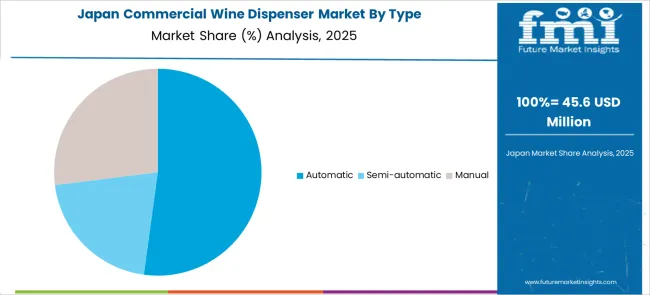
| Country/Region | Japan |
|---|---|
| Statistics | Japan is projected to dominate the Asia Pacific commercial wine dispenser market. The Asia Pacific wine market is expected to witness significant growth by the end of 2035, recording a CAGR of 8.5% throughout the forecast period, affecting the adoption of wine dispensers. |
| Growth Propellants |
The aspects contributing to the growth of the market are:
|
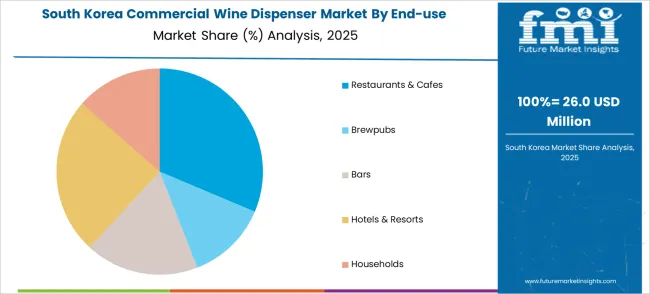
| Country/Region | Korea |
|---|---|
| Statistics | As per the industry data, Korea has the most attractive market for wine, with 51.7 million consumers and a high-spending middle class. In the base year, the sale of wine accounted for nearly 4.6% of the total alcoholic beverage sale in Korea. The market valuation is estimated to surpass USD 3,650.73 Million by the end of 2035. |
| Growth Propellants |
The factors responsible for the growth of the commercial wine dispenser market in Korea are:
|
New Entrants Cede a Silver Lining to the Commercial Wine Dispenser Market
The new entrants in the commercial wine dispenser market are leveraging advancements in technology to launch new products and gain a competitive advantage. These firms are continually investing in research and development activities to keep themselves in tandem with the changing consumer preferences and end-use industry demands.
Efforts are being made to strengthen their foothold in the forum and aid the further progression of the cider brewing equipment market.
Top Start-ups to Watch for
Albi has recently launched its Albi Home M+ in its commercial wine dispenser family. It is an eco-conscious smart wine dispenser with an AI-powered energy saver, which can now optimize energy consumption b recognizing the best time to be activated by itself. There are three different cooling modes to optimize consumption and an automatic vacuum function to prevent oxidation and ensure longer preservation of wine.
Wineemotion has launched its exclusive range of wine dispensers that are designed in a way to preserve the wine for up to 30 days, transforming the waste into profits. It has a unique ISOl-PLUS system that keeps the aromas and fragrances intact of the wine.
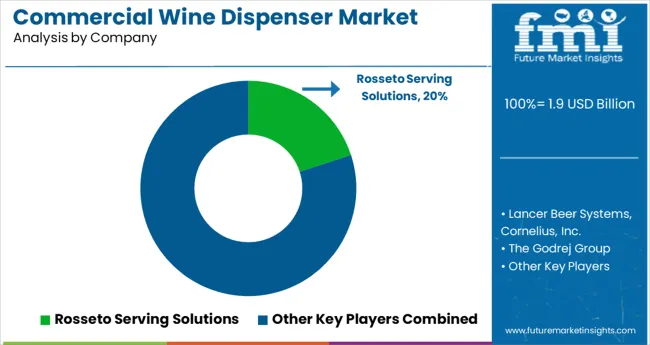
Key Market Players and their Attempts to Revolutionize the Market
This statistical study conducted by Future Market Insights of the concerned equipment market encompasses successful business strategies deployed by the key vendors for wine dispensing. The commercial wine dispenser market is fragmented and the vendors are deploying organic and inorganic growth strategies to compete in the market.
The manufacturers are heavily investing in research and development activities to make technological advances in the machinery for giving better quality wine to the consumers that are loaded with antioxidants and other health-beneficial properties that regulate the heart rate, metabolism, and others. The key manufacturers of the commercial wine dispenser market are entering into strategic collaborations and partnerships to further strengthen their foothold in the market.
Elanpro has designed its new wine dispenser for improved services. The product is designed to chill, dispense, and preserve a dazzling array of red and white wines making wine by the glass a profitable reality. An integral part of a profitable wine-by-the-glass program is to reduce waste, and over-pouring, and to increase convenience for maximum return on investment.
The state-of-art wine for you adds a new level of wine storage complementing functionality and style to every professional set-up. The product is available in 4-12 bottle options considering a restaurateur’s current needs and future aspirations. The new wine dispenser from Elanpro uses nitrogen to displace incoming air to avoid any change in flavor or color.
Plum is another company that has recently launched its automatic server and wine keeper. This is the first commercial wine dispenser to automatically preserve, chill, and serve any bottle, by the glass.
Recent Developments
Some of the key players in the market are:
The global commercial wine dispenser market is estimated to be valued at USD 1.9 billion in 2025.
It is projected to reach USD 3.1 billion by 2035.
The market is expected to grow at a 5.1% CAGR between 2025 and 2035.
The key product types are automatic, semi-automatic and manual.
restaurants & cafes segment is expected to dominate with a 37.0% industry share in 2025.






Full Research Suite comprises of:
Market outlook & trends analysis
Interviews & case studies
Strategic recommendations
Vendor profiles & capabilities analysis
5-year forecasts
8 regions and 60+ country-level data splits
Market segment data splits
12 months of continuous data updates
DELIVERED AS:
PDF EXCEL ONLINE
Commercial Blast Freezer Market Size and Share Forecast Outlook 2025 to 2035
Commercial Water Heater Market Size and Share Forecast Outlook 2025 to 2035
Commercial High-Speed Oven Market Size and Share Forecast Outlook 2025 to 2035
Commercial Turboprop Aircrafts Market Size and Share Forecast Outlook 2025 to 2035
Commercial Vehicle Foundation Brakes Market Size and Share Forecast Outlook 2025 to 2035
Commercial Vehicle Brake Chambers Market Size and Share Forecast Outlook 2025 to 2035
Commercial Vehicles LED Bar Lights Market Size and Share Forecast Outlook 2025 to 2035
Commercial Vehicle AMT Transmission Market Size and Share Forecast Outlook 2025 to 2035
Commercial Greenhouse Market Size and Share Forecast Outlook 2025 to 2035
Commercial Vessel Market Size and Share Forecast Outlook 2025 to 2035
Commercial Slush Machine Market Size and Share Forecast Outlook 2025 to 2035
Commercial Medium Voltage Distribution Panel Market Size and Share Forecast Outlook 2025 to 2035
Commercial Earth Observation (CEO) Market Size and Share Forecast Outlook 2025 to 2035
Commercial Ozone Generator Market Size and Share Forecast Outlook 2025 to 2035
Commercial Gas-Fired Boiler Market Size and Share Forecast Outlook 2025 to 2035
Commercial Deep Fryer Parts & Accessories Market Size and Share Forecast Outlook 2025 to 2035
Commercial Gas Restaurant Ranges Market Size and Share Forecast Outlook 2025 to 2035
Commercial Heat Pump Market Size and Share Forecast Outlook 2025 to 2035
Commercial Countertop Ranges Market Size and Share Forecast Outlook 2025 to 2035
Commercial Electric Restaurant Ranges Market Size and Share Forecast Outlook 2025 to 2035

Thank you!
You will receive an email from our Business Development Manager. Please be sure to check your SPAM/JUNK folder too.
Chat With
MaRIA